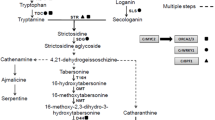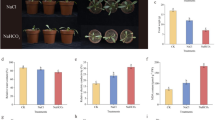Abstract
Supply of 0.5 mM Na2AsO4 significantly decreased the δ-amino levulinic acid (ALA) content and total chlorophylls in greening maize leaf segments with the effect being more substantial for the later. Inclusion of precursors of chlorophyll also affected the ALA content. Thus, % decrease by arsenic (As) was significantly reduced in the presence of glutamine and MgCl2, but was increased by glycine and succinate. ALA formation and chlorophyll content were significantly decreased by 0.5 mM Na2AsO4 during levulinic acid treatment in light as well as dark with more severe effect in light. Difference in ALA accumulation in light and dark (L–D) was also substantially decreased by higher concentrations of As. Inclusion of succinate and MgCl2, respectively, increased and decreased the % inhibition of ALA formation in light. In dark the addition of 2-oxoglutaric acid (2-OG), succinate and glycine caused an increase in % inhibition of ALA formation, while glutamate caused a decrease in inhibition. Inclusion of adenosine tri phosphate (ATP) increased the ALA formation in light in presence of As only, while pyridoxal phosphate (PLP) and MgCl2 enhanced it under both conditions. The results demonstrate more prominent decrease in total chlorophylls than ALA content and/or formation in the presence of As, indicating the involvement of other steps of chlorophyll biosynthesis in addition to ALA synthesis. Substantial decrease under dark at higher concentrations of As and protective effect of cofactors, such as, MgCl2, PLP and ATP in ALA formation in light suggests that chloroplastic ALA synthesizing activity is more sensitive to the presence of As.

Similar content being viewed by others
References
Abedin, M. J., Feldman, J., & Meharg, A. A. (2002). Uptake kinetics of arsenic species in rice plants. Plant Physiology, 128, 1120–1128.
Avissar, Y. J., & Beale, S. I. (1989). Identification the enzymatic basis for δ-aminolevulinic acid auxotropy in a hem A mutant of E. coli. Journal of Bacteriology, 171, 2919–2924.
Avissar, Y. J., Ormerod, J. G., & Beale, S. I. (1989). Distribution of δ-aminolevulinic acid biosynthetic pathways among phototropic bacterial groups. Archives of Microbiology, 151(6), 513–519.
Beale, S. I. (1978). δ-aminolevulinic acid in plants: its biosynthesis, regulation and role in plastid development. Annual Review of Plant Physiology, 29, 95–120.
Beale, S. I., & Weinstein, J. D. (1989). Tetrapyrrole metabolism in photosynthetic organisms. In H. A. Daileyed (Ed.), Biosynthesis of Haeme and Chlorophylls (pp. 287–391). New York: McGraw-Hill.
Castlefranco, P. A., & Beale, S. I. (1981). Chlorophyll biosynthesis. The Biochemistry of Plants, 8, 375–421.
Duggan, J. F., Meller, E., & Gasmann, M. L. (1982). Catabolism of 5-aminolevulinic acid to CO2 by etiolated barley leaves. Plant Physiology, 69, 19–22.
Granick, S., & Beale, S. I. (1978). Hemes, chlorophylls and related compounds: Biosynthesis and metabolic regulation. In A. meister (Ed.), Advances in Enzymology (Vol. 46, pp. 33–203). New York: Wiley.
Hameed, M., EL-Shora, Ahmed, M., & El-Gawad, Abd. (2014). Environmental toxicity of arsenic on Lupine Lupinustermisl.) as C3 crop plant and possible alleviation. International Journal of Agriculture and Crop Sciences, 10(7), 687–692.
Harel, E., & Klein, S. (1972). Light dependent formation of delta aminolevulinic acid in etiolated leaves of higher plants. Biochemical Biophysical Research Communication, 49(2), 364–370.
Harrel, J. (1978). Chlorophyll biosynthesis and its control. In L. Reinhold, J. B. Harborne, & T. Swain (Eds.), Progress in Phytochemistry (Vol. 5, pp. 127–179). Oxford: Pergamon Press.
Huang, L., & Castlefranco, P. A. (1990). Regulation of 5- aminolevulinic acid (ALA) synthesis in developing chloroplasts. Plant Physiology, 92, 172–178.
Jain, M., & Gadre, R. (1997). Effect of As on chlorophyll and protein contents and enzymic activities in greening maize tissues. Water, Air, and Soil pollution, 93, 109–115.
Jain, M., & Gadre, R. (2004). Inhibition of 5-aminolevulinic acid dehydratase activity by arsenic in excised etiolated maize leaf segments during greening. Journal of Plant Physiology, 161, 251–255.
Kannangara, C. G., Gough, S., Bruyant, P., Hoober, J. K., Kahn, A., & Von Veltsten, D. (1989). tRNAGlu as a cofactor in δ-aminolevulinate biosynthesis : Steps that regulate chlorophyll synthesis. Trends in Biochemical Sciences, 13, 139–143.
Lee, J. S., Lee, S. W., Chon, H. T., & Kim, K. W. (2008). Evaluation of human exposure to arsenic due to rice ingestion in the vicinity of abondoned Myunbong Au-Ag mine site. Korean Journal of Geochemical Exploration., 90, 231–235.
Lichtanthaler, H., & Wellburn, A. (1983). Determination of total carotenoids and Chl. a and Chl. b of leaf extracts in different solvents. Biochemical Society Transactions, 603, 591–592.
Lissela, F. S., Long, K. R., & Scott, H. G. (1972). Health aspects of arsenicals in the environment. Journal of Environmental Health, 34, 511–518.
Marin, A. R., Pezeshki, S. R., Masscheleyn, P. H., & Choi, H. S. (1993). Effect of dimethylarsinic acid (DMAA) on growth, tissue arsenic and photosynthesis of rice plants. Journal of Plant Nutrition, 16, 865–880.
May, B. K., Bhaskar, C. R., Bawden, M. J., & Cox, T. C. (1990). Molecular regulation of 5-aminolevulenate synthetase. Molecular Biology and Medicine, 7, 405–421.
Miteva, E., & Merakchiyska, M. (2002). Response of chloroplasts and photosynthetic mechanism of bean plants to excess arsenic in soil. Bulgarian Journal of Agricultural Science, 8, 151–156.
Naito, K., Ebato, T., Endo, Y., & Shimizu, S. D. (1980). Effect of benzyl adenine on δ-aminolevulinic acid synthetic ability and δ-aminolevulinic acid dehydratase: differential responses to benzyl adenine according to leaf age. Planzen Physiology, 96, 95–102.
Nogaj, L. A., & Beale, S. I. (2005). Physical and kinetic interactions between glutamyl-tRNA reductase and glutamate-1-semialdehyde aminotrasferase of Chlamydomonas reinhardtii. Journal of Biological Chemistry, 280, 24301–24307.
Ormrod, D. P. (1978). Pollution in Horticulture. Amsterdam: Elsvier. Xi + 260 pp. illustrations.
Prasad, D. D. K., & Prasad, A. R. K. (1987). Altered δ-ALA metabolism by lead and mercury in germinating seedlings of bajra (Penninsetum typhoideum). Journal of Plant Physiology, 127, 241–250.
Shaibur, M. R., & Kawai, Shigenao. (2011). Arsenic toxicity in akitakomachi rice in presence of Fe3+-EDTA. Bangladesh Journal of Agricultural Research, 36(4), 553–562.
Tewari, A. K., & Tripathy, B. C. (1998). Temperature stress—induced impairment of chlorophyll biosynthetic reactions in cucumber and wheat. Plant Physiology, 117, 851–858.
Troxler, R. F., & Brown, A. S. (1975). Metabolism of δ-aminolevulinic acid in red and blue-green algae. Plant Physiology, 55, 463–467.
Ujwal, M. L., McCormac, A. C., Goulding, A., Kumar, A. M., Soll, D., & Ferry, M. J. (2002). Divergent regulation of the HEMA gene family encoding glutamyl-tRNA reductase in Arabidopsis thaliana: expression of HEMA2 is regulated by sugars but is independent of light and plastid signaling. Plant Molecular Biology, 50, 83–91.
Walsh, L. M., & Kenney, D. R. (1975). Behaviour and phytotoxicity of inorganic arsenicals in soils. In E. A. Woolson (Ed.), Arsenical Pesticides (Vol. 7, pp. 35–52). Madison: ACS. Symp Ser.
Wickes, W. A., & Wishich, J. T. (1986). Arsenate uncoupling of oxidative phosphorylation in isolated plant mitochondria. Australian Journal of Plant Physiology, 3, 153–162.
Author information
Authors and Affiliations
Corresponding author
Rights and permissions
About this article
Cite this article
Jain, M., Thapa, M., Pradhan, P. et al. Effect of arsenic on δ-aminolevulinic acid formation in greening maize leaf segments. Ind J Plant Physiol. 20, 191–196 (2015). https://doi.org/10.1007/s40502-015-0158-3
Received:
Accepted:
Published:
Issue Date:
DOI: https://doi.org/10.1007/s40502-015-0158-3




